How to Properly Mulch Around Your Trees

Introduction
Mulching around trees isn't just an aesthetic choice; it's a fundamental aspect of tree care that nurtures their well-being and longevity. The benefits extend far beyond aesthetics, encompassing weed control, moisture retention, temperature regulation, erosion prevention, and disease management.
Knowing how to mulch properly and choosing the right materials can significantly impact the health of your trees and the overall beauty of your landscape.
In this comprehensive guide, we'll delve into the dos and don'ts of mulching, explore various mulch types, and provide step-by-step instructions to ensure you properly mulch around your trees for a thriving, picturesque environment.
Why Mulch Around Your Trees?
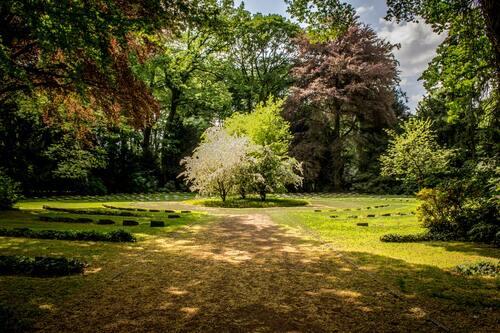
Healthy, Well-Mulched Trees in a Beautiful Setting
Mulching around your trees offers several benefits, making it a worthwhile landscaping practice. Here's why you should consider it:
Weed Suppression
Mulch serves as a natural weed barrier, reducing weed growth around your trees. This helps eliminate competition for water and nutrients, ensuring your trees receive what they need to thrive.
Moisture Retention
Mulch prevents water from evaporating due to sunlight, allowing it to be absorbed by the soil around your tree roots. This retained moisture is vital for the overall health of your trees, especially during dry periods.
Temperature Regulation
During hot weather, mulch acts as an insulator, keeping the tree's roots cool. This temperature regulation prevents stress on the tree and helps it remain healthy.
Erosion Prevention
Mulch also plays a role in preventing soil erosion by acting as a protective layer on the ground. It shields the soil from heavy rain and runoff, preserving the integrity of the tree's root system.
Disease Prevention
For newly planted trees, mulch acts as a protective barrier, helping to keep fungal spores and diseases at bay. It also shields the tree trunk from potential damage by lawnmowers and other landscaping tools.
Now that you understand the benefits, let's explore the proper way to mulch your trees.
What You Shouldn't Do When Mulching
While mulching is beneficial, there are some common mistakes you should avoid:
Excessive Mulch
Don't create a "mulch volcano" by piling up excessive mulch around the tree trunk. An excessive amount of mulch can lead to water runoff and can deprive the tree of essential moisture. Avoid having more than two or three inches of mulch around the tree, as deeper mulch layers can trap water and suffocate the tree's roots, potentially killing it.
Mulch Against the Tree Trunk
Avoid piling mulch directly against the tree trunk. This creates a moist environment that can lead to rot and disease. Leave a small gap, about an inch or two, between the mulch and the tree base to allow for proper air circulation.
Steps to Properly Mulch Around Your Trees
Follow these steps to ensure safe and proper mulching for your trees:
1. Clear the Area
Begin by clearing the area around the tree. Remove rocks, excess dirt, or old mulch to expose the tree trunk. This step allows you to assess the condition of the tree and ensure there are no obstructions.
2. Trim Upward-Growing Roots
Use pruners to trim any roots growing above the ground. Roots that grow too high can wrap around the tree's base and eventually kill it. Upward-growing roots are often a sign that the tree is starving for oxygen.
3. Remove Weeds
Clear the area around the base of the tree of grass and other weeds using a gardening claw or spade. Ensure the area is entirely weed-free to prevent competition for nutrients.
4. Choose the Right Mulch
Selecting the right mulch is crucial for your tree's health. Here are different types of mulch to consider:
Organic Mulch
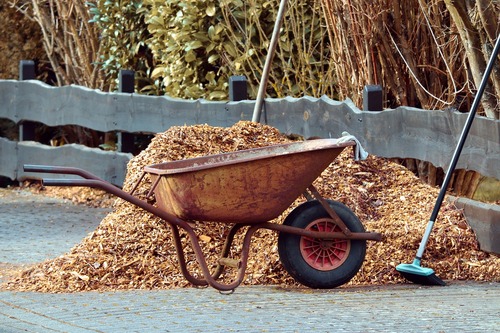
This Mulch is Ready to Be Loaded in to a Wheelbarrow
- Wood Chips or Bark Mulch: Made from shredded or chipped tree bark, these mulches decompose slowly, enriching the soil with organic matter and nutrients.
- Straw or Hay: Ideal for vegetable gardens, these mulches help retain moisture and regulate soil temperature.
- Pine Needles: Particularly suitable for acid-loving plants like azaleas and blueberries due to their acidic nature.
Inorganic Mulch
- Gravel or Rocks: These types of mulch don't decompose and provide excellent weed control. They also retain heat and drain water effectively.
- Rubber Mulch: Made from recycled rubber, this mulch is long-lasting, doesn’t attract pests, and is good for playgrounds or areas where safety is a concern.
Living Mulch
Living mulch involves planting low-growing ground covers that act as a living protective layer around trees. These include:
- Clover: An excellent living mulch that adds nitrogen to the soil and helps suppress weeds.
- Creeping Thyme: Creates a beautiful ground cover while also providing a pleasant aroma.
5. Apply the Mulch
Spread the chosen mulch in a circular pattern around the tree, creating a three-to-five-foot-diameter mulch bed. Spread it in a thin layer, ensuring it doesn't touch the tree trunk. Leave an inch or two of space between the mulch and the tree base.
6. Maintain the Depth
Continue to lay down mulch until it reaches a depth of two to four inches. Avoid creating mounds or hills of mulch; instead, keep it level around the tree.
7. Create a Barrier
To prevent mulch from spilling over, create a border around the mulch bed using stones, wood, or additional mulch. This not only enhances the aesthetics but also provides a practical boundary for the mulched area.
8. Seasonal Mulching
Consider seasonal mulching to maintain the health of your trees. In the spring, replenish mulch as necessary to maintain the recommended depth. During the fall, you may want to refresh the mulch bed to prepare your trees for the winter season.
9. Monitor Moisture
Regularly check the moisture level around your trees. Mulch should help retain moisture, but you may need to water their root zones during dry spells to ensure their well-being.
Benefits of Proper Mulching
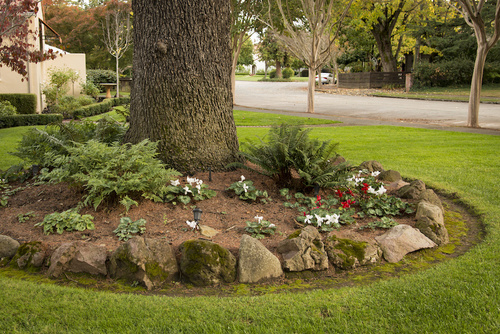
Proper Mulching Helps Plants Thrive at the Base of This Tree
Proper mulching not only enhances the aesthetics of your landscape but also provides several long-term benefits for your trees and the environment:
Tree Health
Well-mulched trees are healthier and more resilient. They are less prone to stress, diseases, and root damage. Mulch helps maintain consistent soil moisture and temperature, ensuring optimal growing conditions.
Weed Control
Mulch serves as a natural weed barrier, reducing the need for chemical weed control methods. This benefits the environment and reduces the maintenance required to keep your landscape looking its best.
Soil Improvement
As organic mulch decomposes, it enriches the soil with nutrients, improving its overall quality. This can benefit not only your trees but also the surrounding vegetation.
Erosion Prevention
Mulch acts as a protective layer against soil erosion. It minimizes the impact of heavy rains and runoff, helping to preserve the structural integrity of the soil around your trees.
Water Conservation
Mulch retains moisture in the soil, reducing the need for frequent watering. This not only saves you time and effort but also promotes water conservation, making your landscape more environmentally friendly.
Mulch Alternatives
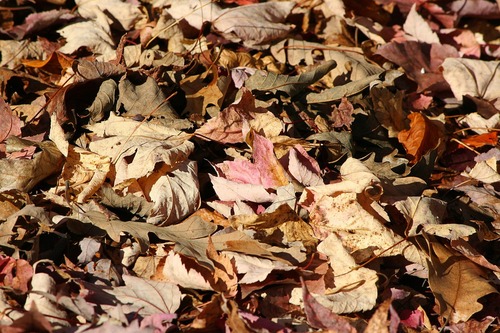
Fallen Leaves are a Great Mulching Alternative
In addition to traditional mulches, there are alternative options to consider:
Newspaper or Cardboard
Lay down sheets of newspaper or cardboard around trees, covering them with a layer of organic or inorganic mulch. These materials act as effective weed barriers and decompose over time, enriching the soil.
Cocoa Bean Hulls
Cocoa bean hulls serve as an aromatic and attractive mulch option. They break down slowly, enriching the soil and providing a delightful fragrance.
Seaweed
For coastal areas, seaweed makes an excellent mulch. It contains beneficial nutrients and minerals that enrich the soil while deterring pests.
Grass Clippings
Grass clippings from your lawn can act as a mulch. However, ensure that the grass was not treated with herbicides or pesticides that could harm your trees.
Shredded Leaves
Leaves collected from your yard can be shredded and used as mulch. They break down gradually, adding nutrients to the soil.
Common Tree Mulching Questions
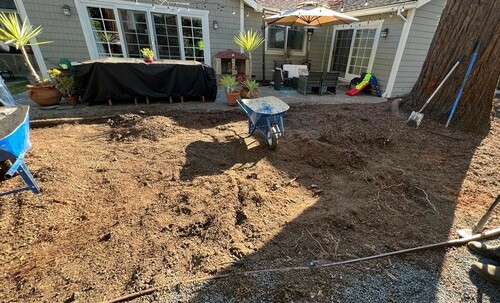
A Backyard Project in Progress
Mulching around trees involves various considerations. Here are answers to some frequently asked questions about tree mulching:
How often should I mulch my trees?
Answer: It's ideal to mulch your trees annually or as needed. Replenish mulch in the spring to maintain the recommended depth and refresh the mulch bed during the fall to prepare trees for winter.
Can I use grass clippings as mulch around trees?
Answer: Yes, grass clippings can be used as mulch, but ensure they are untreated with herbicides or pesticides. Apply a thin layer and avoid compacting to allow air circulation.
How thick should the mulch layer be around trees?
Answer: Maintain a mulch layer depth of two to four inches. Avoid excessive mulching, as it can suffocate tree roots and create a habitat for pests.
Is it necessary to remove old mulch before applying a new layer?
Answer: It's advisable to remove old mulch if it has formed a thick mat or if it's causing drainage issues. Clearing away old mulch allows for proper aeration and prevents excessive moisture buildup.
Can mulch touch the tree trunk?
Answer: No, mulch should not touch the tree trunk directly. Leave a gap of about an inch or two between the mulch and the tree base to prevent rot and pests.
Should I use organic or inorganic mulch around my trees?
Answer: Both organic and inorganic mulches have their benefits. Organic mulches, like wood chips or straw, enrich the soil as they decompose. Inorganic mulches, such as gravel or rubber, provide long-term weed control.
What are the advantages of living mulch around trees?
Answer: Living mulch, like low-growing plants or ground covers, offers weed suppression, soil retention, and additional aesthetic appeal. It can also contribute nutrients to the soil as it grows.
How can I prevent mulch from washing away during heavy rain?
Answer: Creating a barrier using stones, wood, or additional mulch around the mulch bed helps prevent washout. Additionally, periodically checking and replenishing mulch can maintain its effectiveness.
Can mulching help with water conservation?
Answer: Yes, mulch plays a significant role in retaining soil moisture, reducing the need for frequent watering. It helps conserve water while maintaining optimal moisture levels for tree roots.
What is the best time of year to mulch trees?
Answer: Spring and fall are excellent times to mulch trees. In spring, mulch helps retain moisture during warmer months, and in fall, it prepares trees for winter by providing insulation.
Conclusion
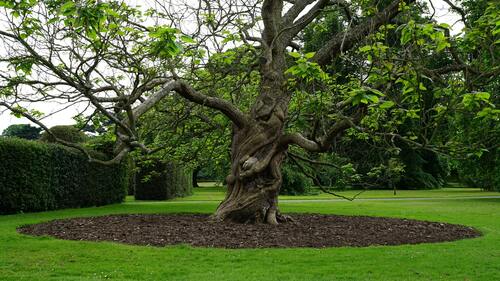
Proper Mulching Helps Keep This Ancient Tree Healthy
Properly mulching around your trees is a valuable addition to your landscaping routine. It enhances the overall health and appearance of your trees, providing numerous benefits, such as weed suppression, moisture retention, temperature regulation, erosion prevention, and disease prevention.
Avoid common mistakes like excessive mulch and mulching against the tree trunk. Instead, follow the recommended steps, choose the right mulch type or alternative, and maintain a healthy mulch bed around your trees. By investing the time and care required, your trees will flourish and bring beauty to your landscape for years to come.
For expert advice and assistance with your tree care needs, contact our team of professionals. We are here to help you achieve a beautiful and thriving landscape that not only enhances the aesthetics of your property but also promotes the health and well-being of your beloved trees. With the right mulching practices and suitable mulch choices or alternatives in place, your trees will thrive, and your landscape will be a source of pride and beauty for years to come.
Originally posted on July 27, 2018
We may receive affiliate compensation for some of the links below at no cost to you if you decide to make a purchase.





